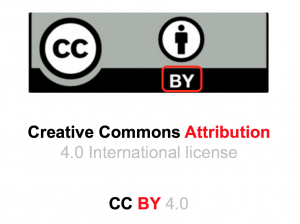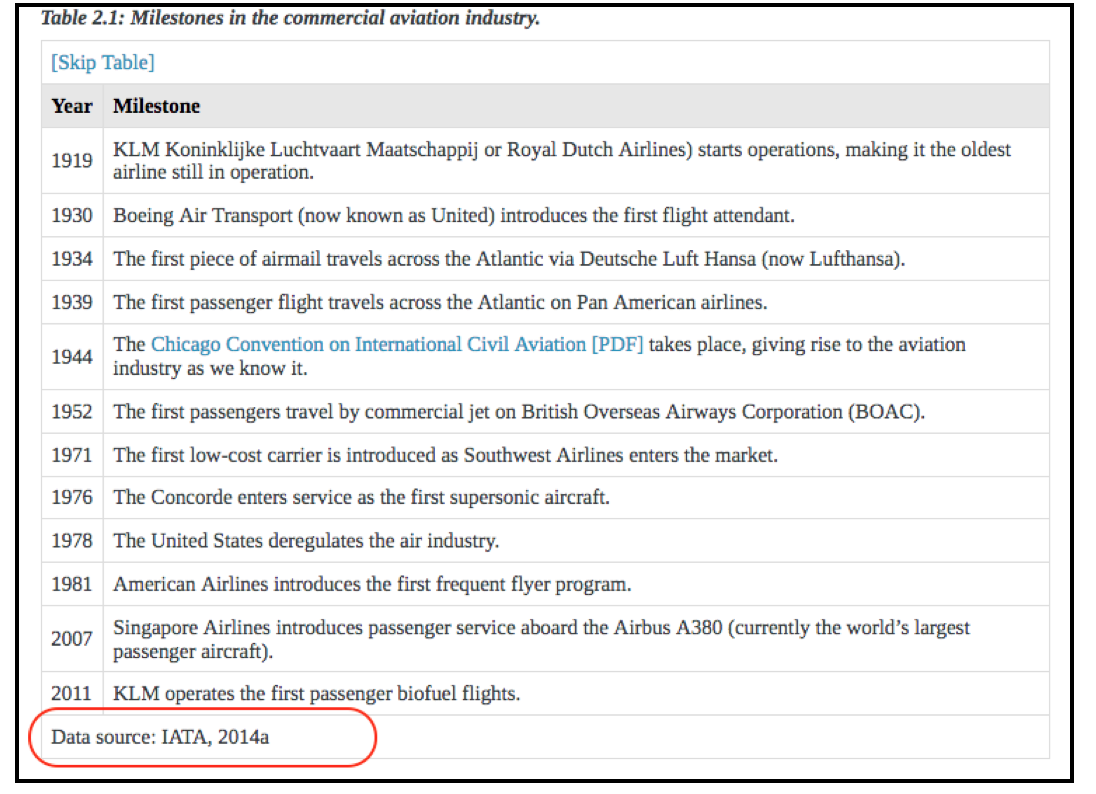21 Citation vs. Attribution
Outside ideas and information provide evidence that build an argument or lay the foundation for a textbook’s topic. A strong textbook will appropriately reference these sources, showing the student reader where information and ideas that do not originate with the open textbook author come from. This should be done for both restricted and open works through citations and attribution statements. Use this as an opportunity to show students by example how a scholar respects and shares information from other sources.
Even though they share characteristics, citations and attributions play different roles and appear in different places. This chapter defines citation and attribution, explains how and when they should be used in an open textbook, and discusses their purposes, similarities, and differences.
Citation
A citation allows authors to provide the source of any quotations, ideas, and information that they include in their own work based on the copyrighted works of other authors. The Oxford Living Dictionary defines it as a “…quotation from or reference to a book, paper, or author, especially in a scholarly work.”[1]
Citation is a common and long-time practice among scholars used to indicate where a resource is from and who the author is. Unlike an attribution, citation is typically used for copyrighted works with restricted rights or “all rights reserved.” In other words, it is used in works for which broad permissions have not been granted.
As a scholar and potential author of an open textbook, we assume that you are familiar with the rules around citation. However, the article Warning: When You Must Cite [New Tab] from the Yale Center for Teaching and Learning provides some guidance about how, what, and the amount of a work that can be cited. (See Textbook Citation.)
Attribution
Attribution is the cornerstone condition when using a resource or text released with an open-copyright licence. This legal requirement states that users must attribute — give credit — to the creator of the work. (See Copyright and Open Licences.)
In a CC BY licence, the “CC” stands for “Creative Commons” and the “BY” stands for “Attribution,” or who the work is “by.”

An attribution statement is used to provide credit to the original creator; its purpose is similar to a citation. Best practice says that the statement should include the title of the work, name of the creator, and licence type (with links to each). When using text from another open educational resource, be clear in your attribution statement what section of your textbook contains this information.
A useful tool to help create attribution statements is the OPEN Attribution Builder [New Tab] by Open Washington. (See also Resources: Captions and Attributions.)
Differences
Citation and attribution serve different purposes.
- Citation is used for academic reasons in order to give credit to a colleague for their work as part of academic integrity. It’s also used for legal reasons. Attributing an open work fulfills the legal requirement of the open-copyright licence, which requires you to give credit to the creator of the work.
- Citation is used for restricted works where the copyright holder does not share the rights of the copy with the general public. The opposite is true for cases where attribution is used.
- Citation legally protects an author who wants to refer to someone else’s work and to avoid plagiarism and copyright infringement. The author of an open work has given advanced permission for others to use their work. (See Concerns About Plagiarism and Copyright and Open Licences.)
- When referencing a restricted work with a citation, one must be careful about the amount referenced. Both direct quotations and paraphrasing are permitted. All of an open work may be used with no limitations; attribution is used to give the author of this work credit.
- The closest one can come to altering a restricted work is to paraphrase the original author’s ideas and expression of these ideas. Whereas the author of an open work has provided advanced permission to use AND change their work (except in cases where ND — NoDerivatives — has been applied).
- Citation styles are varied and established. They dictate how to cite or reference a paraphrase or quotation within text (e.g., with an in-text citation or footnote) and how and where to provide the full reference, whether it be in a reference list, a works cited, or a bibliography and the end of a book.
- The styles for attribution statements are still emerging. Current best practice for an attribution statement states it should reside on the same page (digital or printed) as the resource it refers to. Statements can stand alone, e.g., within the caption of an image, or in a list at the bottom of the page.
The following table summarizes the differences between citations and attributions.
| Citation | Attribution |
|---|---|
| Academic and legal purposes (plagiarism and copyright infringement). | Legal purposes (e.g., rules of Creative Commons licences). |
| The rights of the copy (meaning copyright) are NOT shared with the general public by the copyright holder. | Copyright IS shared with the general public by the copyright holder by marking the work with an open-copyright licence. |
| Protects an author who wants to refer to a restricted work by another author. | Author of an open work has given advanced permissions to use their work. |
| Used to quote or paraphrase a limited portion of a restricted work. | Used to quote (or paraphrase) all or a portion of an openly licensed work. |
| Can paraphrase, but cannot change work without permission. | Author has give advanced permission to change work. |
| Many citation styles are available: APA, Chicago, MLA. | Attribution statement styles are still emerging, but there are some defined best practices. |
| A reference list of cited resources are typically placed at the end of the book. | Attribution statements are found on the same page as the resource. |
Similarities
There are also similarities between a citation and attribution.
- Both can be — and often are — copyrighted. (See Copyright and Open Licences.)
- Both give credit to the creator of the original work
- For both restricted and open works, the author or creator of a work might be different from the copyright holder. For example, if a faculty member writes an open textbook, their institution might hold copyright. However, it’s standard practice to attribute the creator – not the copyright holder – in the attribution statement.
- Both can be used for either a newly created work or a revised work
- Both can be used when referring to a portion of another work, though the amount that can be cited from a fully copyrighted work is substantially less than what can be used from an open work
- Both can be used when building an argument or the foundation of a textbook
Tables: A special case
When BCcampus Open Education began publishing open textbooks, we discovered that there were few openly licenced tables that our authors could use. So, with the help of our copy editors, we developed a way to present information in a table format without violating copyright.
We learned during our research that a table is comprised of two parts:
- The style or layout of the table, which displays the information. These elements can include the size, placement, and colour of the cells; the style of fonts; and the wording and placement of column and row headers.
- The data or information contained within the table
| Main Label | Column One | Column Two | Column Three |
|---|---|---|---|
| Row One | |||
| Row Two | |||
| Row Three |
| Main Label | Column One | Column Two | Column Three |
| Row One | Information 1 | Information 2 | Information 3 |
| Row Two | Information 4 | Information 5 | Information 6 |
| Row Three | Information 7 | Information 8 | Information 9 |
Our solution was to instruct authors to create an original table, and then cite the data added to that table. As you can see in the below example from Introduction to Tourism and Hospitality in B.C., we provided the source for the data in the last row in the table. For clarity, we labelled this in-text citation as “Data source.”[2] Alternatively, you could add the source information to a footnote.

The original table, created by the author or a designer working with the author, is an original creation. Because of this, no attribution statement is required. The table design is copyrighted by the author (or designer). However, as the data comes from an external source, it requires a citation. This same process can be applied to charts and graphs.
Citation-Attribution Fusion
The libraries at Thompson Rivers University in Kamloops have come up with a clever solution to the citation versus attribution dilemma. In the Crediting Images found Online section of their APA Citation Style web page, they suggest modifying the APA citation style so it incorporates open licence or public domain information for the image’s caption and reference. Here is an example.
The image and its caption would appear like this:

The corresponding reference would be laid out like this:
Vernon, A. (Photographer). (2007). Yellow-bellied marmot pups – Kamloops, BC [digital image]. Retrieved from Wikimedia Commons website: http://commons.wikimedia.org/wiki/File:Yellow-bellied_Marmot_pups_-_Kamloops,_BC..jpg
Attributions
- The concepts and portions of this text have been taken from Quill West’s presentation for Pierce College called Citations vs. Attributions. And how to deal with them in your work and is used under a CC BY 4.0 Licence.
- Table 2.1 by Morgan Westcott is used under a CC BY 4.0 Licence.
- "citation," Oxford Dictionary, https://en.oxforddictionaries.com/definition/citation (accessed February 6, 2018). ↵
- Morgan Westcott, "Chapter 2: Transportation," in Introduction to Tourism and Hospitality in B.C., ed. Morgan Westcott, (Victoria, B.C.: BCcampus, 2015). https://opentextbc.ca/introtourism/chapter/chapter-2-transportation/. ↵

